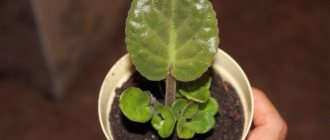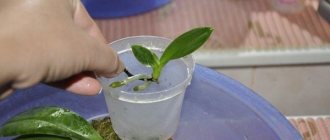Caring for baby violets
Saintpaulia is ready for offspring after 1 calendar year . The countdown is from the planting of the propagation leaf to the end of the first violet flowering.
Violet babies can be obtained in different ways:
- new shoots are obtained vegetatively: from the leaf. The middle leaves of Saintpaulia are disconnected from the mother bush and planted to form children. Cuttings (3 cm from the leaf) are grown in water or in soil. Babies in soil grow into stronger specimens than in water;
- part of the sheet. The sheet is cut by 1/3. This is usually the top of the leaf with veins. The leaf is left to dry after cutting. Then, they are dipped in ash or crushed activated carbon and planted in the ground. It must be pressed tightly with soil. Each vein will produce roots and children;
- stepchildren _ The stepchildren are separated from the mother bush and transplanted into a separate pot;
- from flower stalks. Peduncles are cut off along with stipules and planted in the ground.
This is interesting! When propagated by a fragment of a leaf, the largest number of children appears. When children appear, increase daylight hours to 12 hours and water as needed. Ventilate the greenhouse once a day. They are taken out of the greenhouse at the time of transplantation. Having previously prepared them for room temperature and humidity.
Stages of development
As soon as the leaves appear, cut the leaf in half. This will provide an opportunity to develop faster. If you are going to continue to grow further shoots, then you should not do this. You'll just have to be patient and wait.
Saintpaulia goes through four growth phases before maturity:
- First stage – the appearance of children;
Children of violets. - The second stage - the development of a young plant is called starter . This is the time when the rosette is a teenager, looks like an adult specimen, but is still miniature. Sometimes the color is not yet fully determined, the surface is covered with light spots. During this period, the flower should receive enough light. Turn it periodically around its axis so that the development on all sides is the same. Remove leaves that make the rosette asymmetrical;
- The next phase is a young rosette with a grown cover, bright color, ready to form buds. You can distinguish it from an adult individual by its elastic, shiny leaves;
- The fourth stage is the formation and set of buds . Saintpaulia enters the “violet on buds” stage. Cut off the first buds so that the rosette gets stronger and blooms like a cap. Also remove the stepsons, they delay flowering and make the rosette one-sided. After the flower stops throwing out buds, the plant is ready for new production of offspring.
Separation from the mother plant
The growth of Saintpaulia babies occurs in different ways. Some specimens quickly rise and become overgrown with leaves. Other offspring slow down their development.
When stepchildren appear, certain care requirements must be met. Provide 12 hours of daylight. If this is not the case, arrange additional lighting with lamps.
As soon as there are 4-5 leaves on the offspring, the height will be 4 cm , the plant is ready for transplanting.
You can replant smaller offspring with 3 leaves, but they will require more careful care. Choose the right pot, soil, provide it with consecration, normal humidity, elevated air temperature up to 24 degrees C.
It is important to know! Varieties with dark leaves require more light.
What are juvenile leaves?
The first leaves of the newly grown stepson , which over time become the lower row of Saintpaulias, are called juvenile. They differ from other counterparts in their rounded shape, thin, unexpressed veins, small size, without fluff.
Juvenile leaves are marked in red.
Over time, juvenile leaves acquire an unsightly appearance: they turn yellow and become depleted. To preserve the decorative effect of the flower, they are removed. This is done with a sharp blade or knife. Pre-disinfect the instrument. The cut area is sprinkled with activated carbon.
Some gardeners are trying to propagate violets using them. But, as a rule, babies appear for a very long time and in small numbers. Although some Saintpaulia lovers claim the opposite. This is most likely an exception to the rule.
How to feed violets for abundant flowering at home?
Basic Rules
Fertilizers are classified into:
Organic ones are added directly to the soil when preparing an earthen mixture for violets. This is compost and humus . For lightness and better water permeability, sand is added.
Before fertilizing violets with such fertilizers, it should be noted that this composition should be calcined to remove fungal diseases and pathogens , and after that a young specimen of the plant is transplanted into a container with this earthen mixture.
Mineral fertilizers have different compositions and are:
- one-component (ammonium nitrate, superphosphate);
- complex (aquarine, potassium monophosphate, OMU).
When feeding any houseplants, you need to follow one rule: in winter, the plants rest and gain strength . Violets are no exception.
All fertilizing is carried out starting in the spring , and young plants need more nitrogen, which will provide them with faster growth of leaf mass, and for adults, phosphorus and potassium are much more important for a set of buds and prolonged flowering. The regularity of feeding is once every 2 weeks throughout the spring and summer periods.
Methods
There are several ways to feed violets:
Root
Since industrial fertilizers are classified into highly soluble and poorly soluble in water, their methods of application to the soil also differ:
- if the label indicates that this fertilizer is water-soluble, then it is added to the water during irrigation in the recommended dosages (ammonium nitrate, calcium nitrate, potassium sulfate, potassium nitrate, etc.);
- in the case of using OMU, superphosphate and other fertilizers that are poorly soluble in water, they are added directly to the pot when preparing the soil. Gradually dissolving during watering, the drug will supply the plant with the necessary set of nutrients.
Superphosphate should be added directly to the soil.
Foliar
Foliar feeding is carried out by spraying foliage from a spray bottle . In this case, the dose is taken 2 times lower than the recommended one. It is advisable to spray on the leaf from the underside and avoid getting it on the flowers and the middle of the plant.
To pallet
There are several opinions on watering methods. Some violet lovers claim that the best method of watering is the wick method. The violet will take as much water as it needs, the rest will simply be poured out later.
In this case, you can add soluble fertilizers in microscopic doses to the water when watering the violets in the pan. This method is relevant for a large number of small pots with plants.
Water with fertilizers is poured into a large tray and containers with violets are placed there. After 30 minutes, all the nutrient liquid will be drunk by the Saintpaulia.
How to water with folk remedies?
Some home flower lovers prefer to feed their violets using traditional methods. Therefore, below we will dwell in detail on how to feed violets with folk remedies for maximum benefit.
Black tea
Both the grounds and the aqueous solution of tea itself are used as a fertilizer additive The dried tea leaves are evenly distributed over the surface of the soil of the pot; in this case, it serves as an organic fertilizer, and medium-strength tea is used for feeding.
Violet extracts from tea what it needs for life:
- potassium , with its deficiency the leaves acquire a bluish tint;
- calcium , necessary for the formation of leaves and a powerful root system;
- magnesium takes part in photosynthesis, its lack causes yellowing of the foliage and its premature fall;
- iron is necessary for photosynthesis and protects violets from chlorosis.
Dried tea contains a lot of useful microelements.
In addition, tea contains trace elements in small quantities:
Some housewives simply bury a tea bag in a pot of violets. Tea can be used as a fertilizer once every 14-16 days.
Coffee grounds
Natural coffee lovers can provide their plants with free fertilizer. The dried grounds are mixed with soil and added to a container with growing Saintpaulia , and the plant should be left without watering for 2-3 weeks.
Coffee grounds increase the acidity of the soil in the flower pot and increase the breathability of the soil, making it looser.
From sleeping coffee grounds, violet can get:
- nitrogen , necessary for rapid growth and leaf mass gain;
- phosphorus , needed to increase the number of buds;
- potassium will ensure long flowering;
- calcium gives growth to both the aboveground and underground parts of the plant.
Among the microelements in the sleeping grounds there are copper and iron .
Coffee pulp can be used:
- as drainage;
- mix with soil when planting violets (no more than 10% of the total volume of soil mixture;
- sprinkle the dried grounds onto the surface of the soil in the pot, but not often;
- in liquid form, you should take 1 tsp. grounds per 1 liter of water.
Transplantation from the mother plant
The mother plant helps children and stepchildren gain useful elements for future independent life.
Stepchildren must reach a certain height and gain at least 3 leaves in order to separate from the mother plant.
As soon as all proportions are maintained, the young animals must be separated for further development.
Deadlines
In variegated violets, the babies appear in a light shade . They can be replanted into a separate pot when the leaves have gained enough green pigment. An early landing will lead to their death.
The best time for replanting is summer or autumn , when there is still plenty of daylight.
In winter, growth stops and the plant will sit for a long time without signs of growth. To speed up growth, additional lighting and warmth are installed.
Technology
The separation occurs as follows:
- The offspring, together with the maternal element (leaf, fragment, peduncle), is pulled out of the pot . Freed from the earth;
- The shoots are carefully separated from each other so as not to damage the fragile root system. Small children can be left for further growth with the mother plant;
- Each shoot must have its own root system ;
- If the stepson appears in the axils of the leaves, it is separated with a toothpick . In this case, there is no root system, and the stepson is sent into the ground to form a root.
Separation of the baby from the mother plant.
Seating process
The offspring are pulled out of the pot. They are freed from the ground and separated from each other by hand. Prepare the soil, baking powder, drainage, and pots.
All children are seated in separate containers.
Features of soil and container selection
The soil for young pets should be loose . Buy ready-made soil for violets in specialized stores.
Perlite or vermiculite will help increase breathability Lay the bottom with expanded clay or foam.
The diameter of the first pot should be 3 cm. So that the soil does not become sour and the plant does not die.
The stepson is placed in vermiculite soil.
How to properly bury a violet in the ground
A hole is made in the soil, and the shoot is carefully placed and the roots are straightened. Another layer of moist, but not wet, soil is poured on top.
The growing point should be above the soil level . This is done to prevent moisture from getting into the outlet when watering.
Aftercare
The nuances of how to care for violet babies:
- the air temperature should be between 22-24 degrees C;
- Watering is done with warm, settled water in small portions. Repeated watering is done after the top layer has completely dried;
- a pot with a young plant is placed in a bag or covered with a transparent lid . For example, from under a cake. The flower is left under cover for 3-4 weeks;
Children in the greenhouse.
- as soon as new leaves appear, it means that Saintpaulia has taken root. Gradually teach your teenager to walk without shelter. Only then remove the bag;
- choose a window sill on the northwest or northeast side .
Disease Prevention
Preventive actions and proper care will help you avoid the disease
- using old pots will lead to bacterial diseases, so treat them with boiling water and disinfectants ;
- overwatering can cause the formation of rot;
- hypothermia threatens rotting of the root system and the development of infectious diseases;
- water getting on the leaves leads to the formation of gray rot, botrytis.
Types of fertilizers for violets
Various fertilizers are used to feed Saintpaulia. Once you delve into the structure and understand the rules of application and the needs of the flower, you can achieve abundant flowering for most of the year.
Feedings are:
Simple:
- nitrogen containing;
- phosphate, superphosphate;
- potassium salts.
Since they include one mineral in the structure, they can be added to the soil one at a time. Such fertilizers help to increase the pH level of the soil and make the flowering process more intense.
Complex fertilizers are balanced, saturated with all important mineral components, suitable for saturating the soil even under flowering Saintpaulias:
- Ethisso (nitrogen, phosphorus, potassium);
- Bona Forte (N, P, K);
- Master - universal feeding.
The drugs are produced in the form of powder, liquid, and can be universal or specialized.
Organic - important for saturating the soil before planting. Thanks to organic matter, the vegetative mass gains strength.
Basic nuances of caring for teenagers
The main thing in caring for teenagers is to fulfill some requirements:
- provide consecration for at least 12 hours a day, grow in diffused light;
- monitor air humidity ;
- transplant into another pot in time;
- ensure proper watering ;
- feed on time ;
- In winter, fertilizers are excluded.
Watering and fertilizing
Watering is carried out moderately. Teenagers do not like soil that is too moist . She might turn sour.
After transplanting young plants into separate pots, do not water for 24 hours . If it turns out that the soil has dried out, in this case, pour water into the pan and drain the remainder after 20 minutes.
For overhead watering, use a watering can with a long spout. If water gets on the sheet, blot it with a napkin or toilet paper. Place in the shade until the leaf dries completely. 30 minutes after watering, remove water from the pan.
In adolescence, you can feed the flower with nitrogen fertilizers . From such fertilizers the rosette will gain green mass. In the future it will throw out a large number of buds.
Rules for transplanting into a larger container as you grow
As soon as the plant envelops a lump of earth with its roots, it needs a transplant.
In this case, you need to navigate by the size of the leaves. If their diameter is twice the size of the pot, this is a signal for a new transplant .
The new pot is chosen to be 2 cm larger in diameter.
Size of violet pots.
When will the first flowering occur?
You can expect the first flowering after transplantation in 9 months. The starting point is usually taken from the planting of the propagation leaf. Depending on the variety and care, flowers may appear later. In the first case, it is impossible to bring flowering closer; in the second case, this is corrected.
At the moment of bud formation, flowers require fertilizing with phosphorus and potassium fertilizers. Nitrogen is not recommended in this case, as it will inhibit flowering.
Possible problems
After planting the shoot in a pot, the leaves change. They may be soft. This is not scary, as soon as the plant takes root, the top cover will be restored.
Lethargy after transplantation is temporary.
Sometimes young animals stretch upward, this indicates that they do not have enough light.
Prevention of diseases
- water the young animals with warm water;
- in spring and autumn, carry out preventive treatments against diseases and pests;
- Once a year, replant adult violets and young ones as needed;
- protect from drafts.
Secrets of growing violets
When growing violets, it is important to follow the norm in everything:
- Flowers should not be overwatered or overfed.
- Feeding is done taking into account the basic rule - it is better to underfeed than to overfeed. Oversaturation of the soil leads to intense vegetation.
- With rapid leaf growth, flowers may not appear at all. It is necessary to observe proportions in everything.
Found a mistake? Report it: 1) Select the error with the mouse 2) Press CTRL+Enter. Read more.
Which feeding option is best for baby violets?
1.Organic-mineral fertilizer for Saintpaulia Rost with the following composition: nitrogen-6, phosphorus-4, potassium-4, gum. substances-2, microelements and stimulants- (8-10)
2. Master + UNIVERSAL HUMATE FERTILIZER FOR FLOWERS (sulfate humates, macro- and microelements (N, P, K, Ca, Mg, Fe, Cu, Zn, Co, Mo, B). Or such humate is not allowed for children. If possible, how correctly combine and feed?
- Login or register to post comments
- print version











